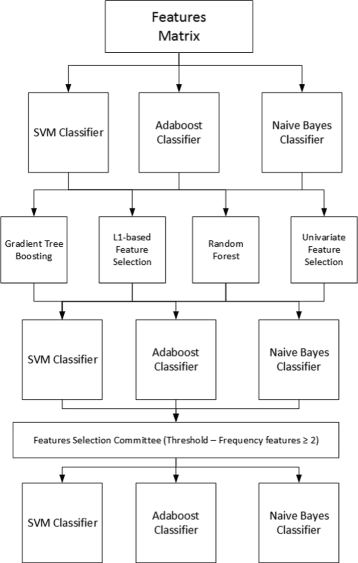Automatic migraine classification via feature selection committee and machine learning techniques over imaging and questionnaire data
- PMID: 28407777
- PMCID: PMC5390380
- DOI: 10.1186/s12911-017-0434-4
Automatic migraine classification via feature selection committee and machine learning techniques over imaging and questionnaire data
Abstract
Background: Feature selection methods are commonly used to identify subsets of relevant features to facilitate the construction of models for classification, yet little is known about how feature selection methods perform in diffusion tensor images (DTIs). In this study, feature selection and machine learning classification methods were tested for the purpose of automating diagnosis of migraines using both DTIs and questionnaire answers related to emotion and cognition - factors that influence of pain perceptions.
Methods: We select 52 adult subjects for the study divided into three groups: control group (15), subjects with sporadic migraine (19) and subjects with chronic migraine and medication overuse (18). These subjects underwent magnetic resonance with diffusion tensor to see white matter pathway integrity of the regions of interest involved in pain and emotion. The tests also gather data about pathology. The DTI images and test results were then introduced into feature selection algorithms (Gradient Tree Boosting, L1-based, Random Forest and Univariate) to reduce features of the first dataset and classification algorithms (SVM (Support Vector Machine), Boosting (Adaboost) and Naive Bayes) to perform a classification of migraine group. Moreover we implement a committee method to improve the classification accuracy based on feature selection algorithms.
Results: When classifying the migraine group, the greatest improvements in accuracy were made using the proposed committee-based feature selection method. Using this approach, the accuracy of classification into three types improved from 67 to 93% when using the Naive Bayes classifier, from 90 to 95% with the support vector machine classifier, 93 to 94% in boosting. The features that were determined to be most useful for classification included are related with the pain, analgesics and left uncinate brain (connected with the pain and emotions).
Conclusions: The proposed feature selection committee method improved the performance of migraine diagnosis classifiers compared to individual feature selection methods, producing a robust system that achieved over 90% accuracy in all classifiers. The results suggest that the proposed methods can be used to support specialists in the classification of migraines in patients undergoing magnetic resonance imaging.
Keywords: Boosting(adaboost); Classification; Committee; DTI; Feature selection; Migraine; Naive bayes; SVM.
Figures

Similar articles
-
Computer-assisted lip diagnosis on Traditional Chinese Medicine using multi-class support vector machines.BMC Complement Altern Med. 2012 Aug 16;12:127. doi: 10.1186/1472-6882-12-127. BMC Complement Altern Med. 2012. PMID: 22898352 Free PMC article.
-
Migraine classification using somatosensory evoked potentials.Cephalalgia. 2019 Aug;39(9):1143-1155. doi: 10.1177/0333102419839975. Epub 2019 Mar 26. Cephalalgia. 2019. PMID: 30913908
-
Breast cancer prediction with transcriptome profiling using feature selection and machine learning methods.BMC Bioinformatics. 2022 Oct 1;23(1):410. doi: 10.1186/s12859-022-04965-8. BMC Bioinformatics. 2022. PMID: 36183055 Free PMC article.
-
Machine learning classification meets migraine: recommendations for study evaluation.J Headache Pain. 2024 Dec 5;25(1):215. doi: 10.1186/s10194-024-01924-x. J Headache Pain. 2024. PMID: 39639193 Free PMC article. Review.
-
[Digitization in the diagnosis and treatment of headache].MMW Fortschr Med. 2024 Nov;166(20):67-69. doi: 10.1007/s15006-024-4435-9. MMW Fortschr Med. 2024. PMID: 39576541 Review. German.
Cited by
-
Delineating conditions and subtypes in chronic pain using neuroimaging.Pain Rep. 2019 Aug 7;4(4):e768. doi: 10.1097/PR9.0000000000000768. eCollection 2019 Jul-Aug. Pain Rep. 2019. PMID: 31579859 Free PMC article. Review.
-
Searching for the Predictors of Response to BoNT-A in Migraine Using Machine Learning Approaches.Toxins (Basel). 2023 May 29;15(6):364. doi: 10.3390/toxins15060364. Toxins (Basel). 2023. PMID: 37368665 Free PMC article.
-
Machine learning in pain research.Pain. 2018 Apr;159(4):623-630. doi: 10.1097/j.pain.0000000000001118. Pain. 2018. PMID: 29194126 Free PMC article. Review. No abstract available.
-
Personalized Body Constitution Inquiry Based on Machine Learning.J Healthc Eng. 2020 Nov 12;2020:8834465. doi: 10.1155/2020/8834465. eCollection 2020. J Healthc Eng. 2020. PMID: 33274038 Free PMC article.
-
Machine learning approach to predict medication overuse in migraine patients.Comput Struct Biotechnol J. 2020 Jun 12;18:1487-1496. doi: 10.1016/j.csbj.2020.06.006. eCollection 2020. Comput Struct Biotechnol J. 2020. PMID: 32637046 Free PMC article.
References
-
- Kira K, Rendell LA. Proceedings of the ninth international workshop on Machine learning. San Mateo: Morgan Kaufmann Publishers; 1992. A practical approach to feature selection.
MeSH terms
LinkOut - more resources
Full Text Sources
Other Literature Sources
Medical

